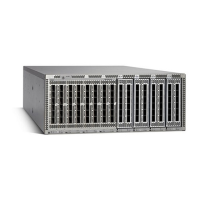CHAPTER 15
Configuring VM-FEX
This chapter contains the following sections:
•
Information About VM-FEX, page 185
•
Licensing Requirements for VM-FEX, page 187
•
Default Settings for VM-FEX, page 187
•
Configuring VM-FEX, page 188
•
Verifying the VM-FEX Configuration, page 196
Information About VM-FEX
VM-FEX Overview
Based on the (prestandard) IEEE 802.1Qbh port extender technology, Cisco Virtual Machine Fabric Extender
(VM-FEX) extends the fabric from the switch chassis to the Virtual Machine (VM). Each VM is associated
with a network adapter vNIC, which is associated with a virtual Ethernet (vEthernet or vEth) port on the parent
switch. This dedicated virtual interface can be managed, monitored, and spanned in the same way as a physical
interface. Local switching in the hypervisor is eliminated, with all switching being performed by the physical
switch.
VM-FEX Components
Server
VM-FEX is supported by Cisco UCS C-Series rack-mount servers with the VMware virtualization environment
as the hypervisor.
The configuration of the server is performed using the Cisco Integrated Management Controller (CIMC)
interface, which provides both a GUI and a CLI interface. The configuration of the hypervisor and virtualization
services is performed using the VMware vSphere client.
For information about CIMC and VM-FEX configuration, see the following documents:
Cisco Nexus 6000 Series NX-OS Layer 2 Switching Configuration Guide, Release 7.x
185

